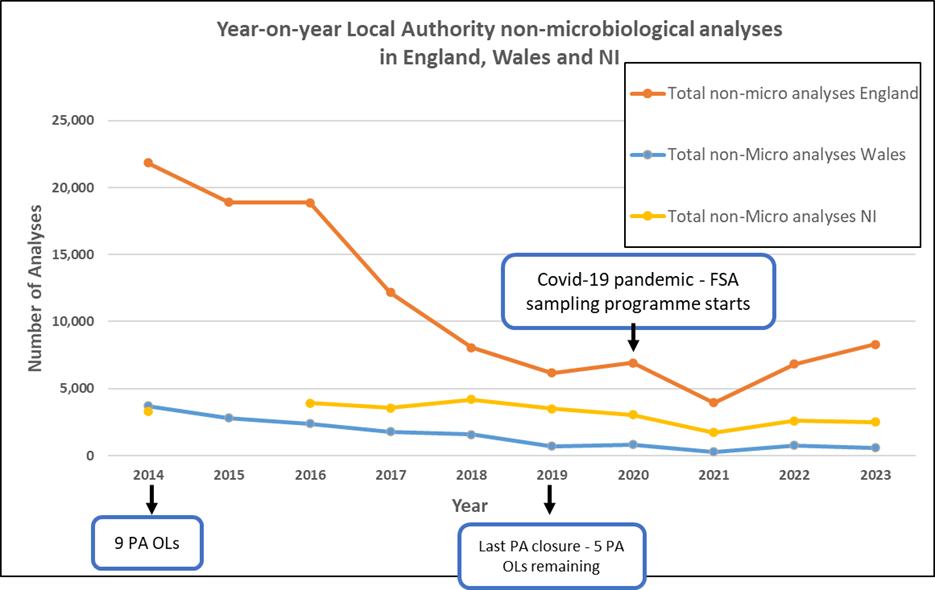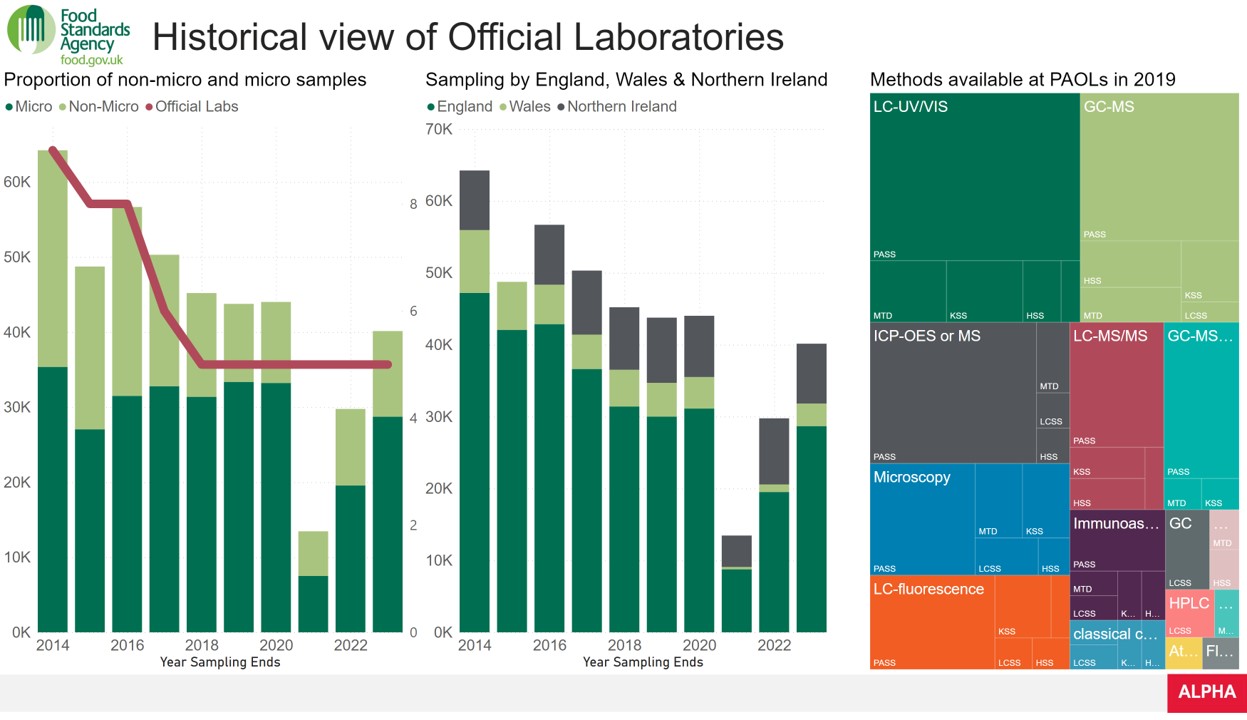Update on GB Official Laboratories Capability Building
BC 23-09-04. This paper provides an update on work delivered to develop GB Official Laboratory (OL) capacity and capability following the September 2022 Board Paper.
1. Summary
This paper provides an update on work delivered to develop GB Official Laboratory (OL) capacity and capability following the September 2022 Board Paper1.
The Business Committee is asked to:
- note and comment on the work completed to date.
2. Introduction
The September Board Paper 2022 outlined the current challenges in the OL system, especially in Public Analysts (PAs) OLs, and the immediate actions the FSA had undertaken to maintain the system (these actions were designated as Phase One of the future laboratories plan).
Through the FSA’s immediate intervention during Phase One, by delivering sampling and supporting laboratory capability, no PA OLs have closed since 2019 (see Annex 1 and Annex 2).
However, despite the remedial action taken, the laboratory system still faces the following challenges:
- overall sampling rates in England and Wales have reduced, leading to a loss of capability in non-routine sampling areas and a lack of capacity due to a historic decline in the number of PA OLs.
- delays in sample turnaround, where samples are sent abroad due to testing capability limitations in UK
- loss of access to European Union Reference Laboratories (EURLs), which develop new analytical methods following EU-Exit.
- declining number of Public Analysts due to retirement.
To address these, four further workstreams were approved by the Board in September 2022 to be delivered between 2022 and 2024 (these constitute Phase Two of the future labs plan):
- Grant Funding schemes to develop PA OLs capability and capacity.
- National Reference Laboratories (NRLs) capability to improve incident response, develop analytical methods and undertake non-routine testing.
- Public Analyst Training, to develop the PAs of the future.
- delivering an Annual Sampling Surveillance Survey and research and development programmes.
3. Phase Two Progress to Date
Grant funding
Approximately £500k is being provided to four PA OLs through the FSA’s Open Capability Building Grant Funding Programme. This grant programme was available to all PA OLs based in England, Wales and Northern Ireland, and funding was available to cover a range of areas, including equipment, staffing, method development and accreditation.
Areas funded will introduce less labour-intensive processes to improve UK capacity, decrease turnaround time for analysis and expanding the range of available testing. The following capability is being delivered:
- metals analysis in food and feed.
- DNA testing, including Genetically Modified Organisms (GMOs) and meat speciation.
- allergens.
- food additives.
- alcohol adulteration.
Following the initial grant call, an additional £100k has been awarded through a second grant scheme, the FSA’s Targeted Capability Grant Funding Programme, to fund areas of testing priority for the FSA. This is funding capability for pesticides, veterinary medicine residues and authenticity testing and will support monitoring of imported food.
Sampling
Since 2020, the FSA has spent £558K on average per year delivering an annual, intelligence-led retail sampling surveillance programme to test hypotheses on potential food safety and standard issues and enable the testing of a wider range of areas than those routinely looked at by local authorities. This sampling and analysis, which is undertaken by PA OLs in England and Wales, has helped maintain core laboratory capability by providing a flow-through of samples. It also provides justification for uptake of grant funding and internal investment to expand PA OLs’ testing capabilities, such as those highlighted in section 3.2.
The FSA also funds two programmes of targeted, official control sampling, conducted by Local Authorities: the grant-funded Imported Food Sampling and the directed Food Standards Sampling Programmes. Directed sampling is intelligence-led and results from the retail surveillance sampling programme, alongside wider intelligence, are used to identify priority food products and risks for sampling. This helps direct budgets to identified food standard risks and with the aim of increasing business compliance. This directed sampling programme resumed in financial year 22/23 and continues into 23/24.
These sampling programmes have also helped to fill the gap left by the historic decline in local authority sampling analyses rates (Annex 1)2. Notably, non-microbiological (i.e., chemical, compositional, authenticity) sampling rates for England, Wales and Northern Ireland fell from 28,865 taken during 2013/14 to 10,398 during 2019. Levels since this point have stabilised and not decreased further, except for the 2020/21 reporting year due to the impact of the pandemic. It is worth noting, the levels of microbiological sampling have remained more constant (as shown in Annex 1).
Method development and training to OLs
The FSA is investing to improve analytical methods and deliver new testing approaches to better prepare the UK food system for the future. It has undertaken research and development to develop innovative technologies and new analytical methods, such as identifying alternative methods for herbs and spices authenticity and a review of allergen testing methods.
Over this financial year, research will be undertaken on the use of Point of Contact technology for food safety and authenticity testing, to review of methods for country-of-origin testing, honey authenticity, and assess methods to test for allergens in alternative proteins such as insects and precision fermentation products.
Alongside this, the FSA has increased the amount of method development undertaken by the UK NRLs, to replace the gap left though losing access to the EURLs. To date the FSA has developed 13 methods and is planning to develop a further six methods this financial year. Priorities include developing testing methods for Per- and polyfluoroalkyl substances (PFAS), cyanogenic glycosides, tropane, and pyrrolizidine alkaloids, and improving methods for determining presence of processing contaminants in food and feed. Where methods will be routinely required for official controls, the NRLs will support and upskill OLs.
To address the decline in the number of PAs and the inability of PA OLs to undertake succession planning, a Public Analyst Training Programme is being delivered to provide MChemA candidates with additional support during their studies and to support the future of the profession (note: the MChemA qualification is a mandatory to become a qualified public analyst). Training events are being organised by the Association of Public Analysts (APA) Training Officer across 2023 into 2024, with extensive engagement with MChemA candidates.
Finally, the FSA has continued to support the cross-government, Joint Knowledge Transfer programme (co-funded by Defra/FSA/Food Standards Scotland (FSS)/Government Chemist), which builds analytical laboratory capability to respond to food safety and fraud incidents. During its first three years (2017-2020) the programme has delivered nine E-seminars and two workshops ranging from allergens, DNA/PCR, GMO, and speciation analysis. All webinars and seminars are openly published.
4. Key Performance Indicators
To measure the success of the programme the following Key Performance Indicators (KPIs) are intended to be delivered by March 2025, subject to budget allocation from the FSA annual budget planning process:
- a minimum of two priority areas identified by the FSA will be added or maintained on the UKAS Accreditation Schedules of PA OLs participating in the Grant Programmes.
- the establishment of a new affordable, multi-test service provided by NRLs allowing OLs to access complex and novel testing methods.
- the UK’s resilience to respond to major food or feed incidents will be improved through having contracts in place with the NRLs to do testing.
- a minimum of six analytical methods will be developed by the UK NRLs.
- at least four methods will be cascaded to PA OLs in targeted areas.
5. The Future: Phase Three
Phase Three will be our final step to deliver the laboratory system we require and will build on the intervention and support delivered in Phase Two. The plan for Phase Three will be developed in 23-24, and subject to Board approval and availability of funding, we will aim to start delivering in the following financial year (24-25). We will use the outcomes of Phase Two to identify what works effectively within the system and where gaps still exist or are emerging. This, along with a survey by the Government Chemist of the capability of PA laboratories (to run in 2023-24), will be the evidence base for identifying remaining gaps in the system and used to deliver the long-term solution for building a resilient national capability.
As well as addressing specific capability gaps, Phase Three will also look to develop further options to improve coordination and efficiencies between laboratories, bolster relevant research and method development, and deliver capability and capacity, in conjunction with other government departments, including FSS, Defra and the Health and Safety Executive (HSE). One concept being explored as an option is the development of a ‘hub and spoke’ model with an overarching, ‘centre of excellence for food safety and standards’ hub operating with existing NRLs and OLs as the spokes. FSA officials and Chief Scientific Advisor are continuing to engage across government to identify cross-departmental solutions to lab capacity and deliver this.
The FSA also continue to assess the capability of the wider UK OL system. For example, an audit of UK OLs undertaking microbiology testing has been completed by UK Health Security Agency (UKHSA)3. Published in July 2023, the full report shows that national microbiological OL capacity has remained stable but identified some specific capability gaps, thus informing of priority areas for future work in this area.
6. Conclusions
FSA support and intervention has stopped further lab closures and maintained UK capability. Phase Two is being delivered, with implemented KPIs developed to monitor progress and the success of the programme. Phase Three is being developed in conjunction with other government departments.
The Business Committee is asked to:
- note and comment on the work completed to date.
7. Appendix
Annex 1: Total number of Analyses undertaken for non-microbiological sampling.

Annex 2: Capability and number of Public Analyst Laboratories.
